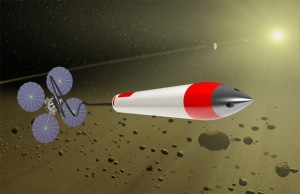
An artist’s conception shows a sampling rocket, with a tether linking a return capsule inside the rocket to a recovery craft. Credit: Univ. of Washington
A University of Washington (UW) class is crashing rockets into the ground…and on purpose.
The student project is called “Sample Return Systems for Extreme Environments,” a novel technology that recently received $500,000 over two years from the NASA Innovative Advanced Concepts (NIAC) program.
Here’s the idea: A rocket hits the surface of a celestial object. It burrows in a short distance with ports on either side of the rocket’s nose collecting a sample. That specimen is then funneled to an interior capsule. The capsule is attached by tether to a balloon or a spacecraft, which would immediately reel in the capsule to recover the sample.
Kite-lofted rockets
In the first phase of testing earlier this year in Black Rock Desert, about 100 miles north of Reno, Nev., kite-lofted rockets were fired from an altitude of 3,000 feet down toward the desert floor.
But it turned out that wasn’t high enough for proper performance testing. Even so, components of the system survived supersonic impact under rocket power.
The second phase of testing could take place in California next summer, with follow up tests a year later. Rockets would be fired from a higher altitude in an attempt to achieve twice the speed of sound, or about 1,520 mph.
“We’re trying to figure out what the maximum speed is that a rocket can survive a hard impact,” said Robert Winglee, a UW professor of Earth and space sciences, who heads that department and leads the annual trek to the desert.
Earth and space applications
The NIAC-backed concept could be used to collect and return samples from forbidding environments, be it an erupting volcano or a melting nuclear reactor here on Earth, or even an asteroid in space.
Winglee said that, on Earth, it would allow scientists a relatively safe way of recovering samples in areas of high contamination, such as Japan’s Fukushima Daichi nuclear power plant and the Chernobyl nuclear power facility in Ukraine, both of which suffered catastrophic failures.
The technology could also collect samples from an erupting volcano to give Earth scientists a better understanding of the processes at work during one of nature’s most violent shows.
In either case, the tethered sample-return capsule could be hauled in by a balloon or a plane.
Tether technology
In space, for example, the system could collect samples from a single asteroid or a series of them, with a “mothership” recovering the tethered capsules and returning them to Earth.
“It would be like taking a core sample before you go mining,” Winglee said in a UW press release. He noted that there is growing interest in possibly mining asteroids, both for finding substances that are in increasingly short supply on Earth, and potentially to find the natural resources to create fuel for long-term space missions.
Winglee is working with Robert Hoyt of Tethers Unlimited Inc. of Bothell, Wash., which has developed tether technology for use in space, on Earth and in the oceans.
Check out this video of the University of Washington’s rocket work at:
http://www.youtube.com/watch?v=ehrJUf-Dk_0
By Leonard David
